
Prasophyllum, commonly known as leek orchids, is a genus of about 140 species of flowering plants in the orchid family, Orchidaceae and is found in Australia and New Zealand. The Australian species are found in all states but have not been recorded in the Northern Territory. The common name arises from their having a hollow, leek- or onion-like leaf. Some species only flower after summer fires and have flowers similar to those of Xanthorrhoea which flower at the same time, suggesting that they employ the same pollinating insects. Leek orchids are similar to those in the genus Genoplesium except that the free part of the leaf is cylindrical and the labellum has a solid connection to the column. They range in size from the little laughing leek orchid at about 15 cm (6 in) to the king leek orchid which grows up to 2 m (80 in) tall.

Leptoceras menziesii, commonly known as rabbit orchid, is a plant in the orchid family, Orchidaceae and the only member of the genus Leptoceras. It is a slender plant, usually found in large colonies and which only flowers after fire. The flowers are small, white, pink and red on a stem up to 30 cm (10 in) tall and is endemic to southern Australia. It was one of the first orchids from Western Australia to be described and was given the name Caladenia menziesii, a name still used by some authorities.

Diuris pardina, commonly known as the leopard orchid or leopard doubletail is a species of orchid which is endemic to south-eastern Australia. It has two or three grass-like leaves and up to ten yellow flowers with reddish-brown marks and blotches.

Diuris laxiflora, commonly called the banded bee orchid or bee orchid is a species of orchid which is endemic to Western Australia. It is a small orchid, common within its range and about half the size of the common donkey orchid, Diuris corymbosa.

Thelymitra antennifera, commonly called the rabbit-eared sun orchid, lemon-scented sun orchid or vanilla orchid is a species of orchid which is native to Western Australia, South Australia and Victoria and northern parts of Tasmania.
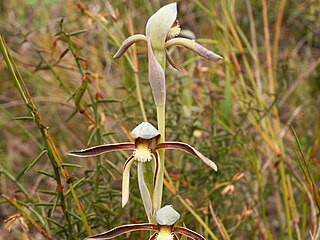
Lyperanthus serratus, commonly called rattle beaks, is a species of orchid which is endemic to the south-west of Western Australia. It derives its name from the fact that the flowers rattle if gently shaken.

Prasophyllum tadgellianum, commonly known as the alpine leek orchid, is a species of orchid native to the Snowy Mountains and Tasmania. It has a single stiff, erect leaf and up to twenty scented, greenish-brown or reddish-brown flowers crowded on a stout spike.
Pterostylis aphylla, commonly known as the leafless greenhood, is a species of orchid endemic to Tasmania. As with similar greenhoods, the flowering plants differ from those which are not flowering. The non-flowering plants have a rosette of leaves flat on the ground but in this species, the flowering plants have a single green and white flower with a brown tip and lack leaves apart from a few small scales.
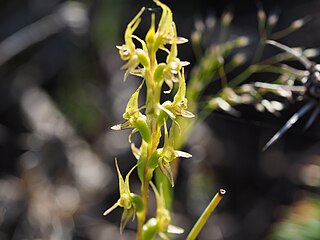
Prasophyllum gracile, commonly known as the little laughing leek orchid, is a species of orchid endemic to the south-west of Western Australia. It is one of the most common and widespread orchids in the south-west and has a single smooth, tube-shaped leaf and up to forty or more, usually yellowish-green flowers.

Prasophyllum affine, commonly known as the heathland leek orchid or Jervis Bay leek orchid, is a species of orchid endemic to New South Wales. It has a single tubular, green leaf and up to fifty scented, green, red, brown and purple flowers. Although the type specimen was collected in the Sydney area in 1803, the species in now only known from three locations near Jervis Bay.
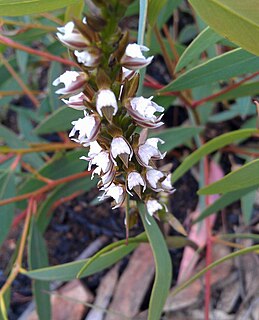
Prasophyllum brevilabre, commonly known as the short-lip leek orchid, is a species of orchid endemic to south-eastern Australia. It has a single tubular, green leaf and up to thirty small, greenish-brown flowers with a white labellum. The labellum is sharply turned back on itself so that its tip almost reaches its base.
Prasophyllum cucullatum, commonly known as the hooded leek orchid, is a species of orchid endemic to the south-west of Western Australia. It is a tall orchid with a single smooth, tubular leaf and up to fifty or more purplish-red and white flowers with a frilled labellum crowded along a relatively short flowering stem.
Prasophyllum giganteum, commonly known as the bronze leek orchid, is a species of orchid endemic to the south-west of Western Australia. It is a tall, fragrant leek orchid with a single smooth, tubular leaf and up to fifty or more green and pinkish-purple flowers with a frilly labellum.
Prasophyllum macrotys, commonly known as the inland leek orchid, is a species of orchid endemic to the south-west of Western Australia. It has a single tubular leaf and up to thirty greenish to purplish flowers and is similar to the tall leek orchid but has smaller, darker flowers.
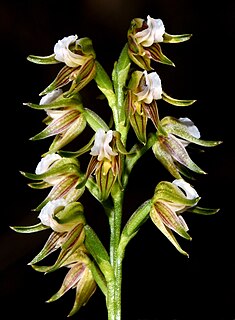
Prasophyllum parvifolium, commonly known as the autumn leek orchid, is a species of orchid endemic to the south-west of Western Australia. It is a common species in its range and has a single smooth, tube-shaped leaf and up to eighteen or more green and white flowers with red stripes.
Prasophyllum ovale, commonly known as the little leek orchid, is a species of orchid endemic to the south-west of Western Australia. It is a small leek orchid with a single smooth, tubular leaf and up to twenty or more white, green and brown flowers with the labellum only slightly upturned.
Prasophyllum rostratum, commonly known as the slaty leek orchid, is a species of orchid endemic to Tasmania. It has a single tubular leaf and up to twenty five well-spaced, greenish-brown flowers. It is similar to P. pyriforme from mainland Australia but lacks that species' white to pinkish labellum.
Prasophyllum truncatum, commonly known as the truncate leek orchid, is a species of orchid endemic to Tasmania. It has a single tubular, dark green leaf and up to twenty whitish flowers with purplish and greenish-brown markings. It is a late-flowering leek orchid and its flowering is stimulated by earlier fire.
Genoplesium brachystachyum, commonly known as the Rocky Cape midge orchid or short-spike midge orchid and as Corunastylis brachystachya in Australia, is a small terrestrial orchid endemic to Tasmania. It has a single thin leaf fused to the flowering stem and up to twelve small, green to brownish green, and reddish flowers. It usually grows in heath in rocky places near the coast.
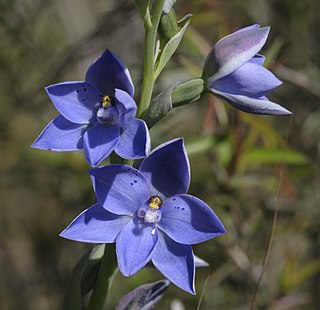
Thelymitra juncifolia, known as the large-spotted sun orchid, is a species of orchid that is endemic to south-eastern Australia and to New Zealand. It has a single thin, dark green leaf and up to five blue flowers with relatively large, dark blue spots on the dorsal sepal and petals. It is similar to T. ixioides but has fewer, smaller flowers with larger dark blue spots.












